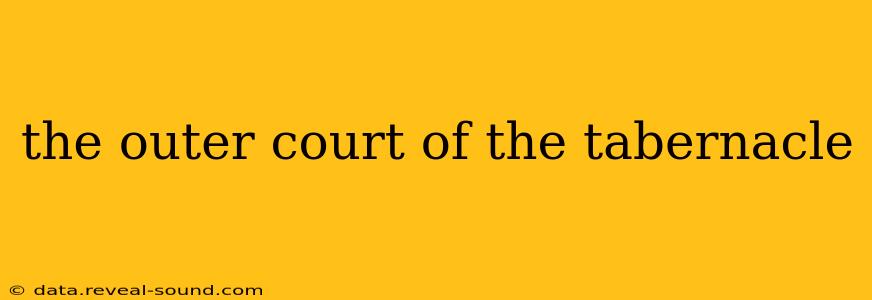The Tabernacle, a portable sanctuary constructed by the Israelites in the wilderness, served as a central place of worship and a visible manifestation of God's presence. Its design, meticulously detailed in the Book of Exodus, is rich with symbolism and meaning. While the Holy of Holies and the Holy Place held the most sacred objects, the outer court, often overlooked, played a crucial role in the overall function and significance of the Tabernacle. This article delves into the details of the outer court, exploring its purpose, features, and significance within the larger context of Israelite worship.
What was the purpose of the outer court of the tabernacle?
The outer court of the Tabernacle served as a transitional space, a liminal area between the everyday world and the sacred space within. Its primary purpose was to provide a place for the priests and the Israelites to prepare for worship and to offer sacrifices. It was here that the daily routines of cleansing, preparation, and sacrifice took place, creating a structured and reverent atmosphere before entering the more sacred inner chambers. The outer court acted as a buffer, a place of purification before approaching God's immediate presence.
What were the main features of the outer court of the tabernacle?
The outer court was a rectangular enclosure, measuring 100 cubits long and 50 cubits wide (approximately 150 feet by 75 feet). Its boundaries were defined by linen curtains hung on pillars of acacia wood, capped with silver capitals. The most prominent feature within the outer court was the brazen altar, located centrally. This altar was where animal sacrifices were offered, representing atonement for sins and reconciliation with God. A large basin, called the laver, situated near the entrance to the Holy Place, was used by the priests to wash their hands and feet before entering the inner sanctuary. This ritual cleansing underscored the importance of purity in approaching God.
What was the brazen altar used for?
The brazen altar, made of bronze, was the focal point of sacrificial worship in the outer court. It was not merely a place for burning offerings; it symbolized the atonement of sin. The smoke from the burnt offerings ascended as a fragrant plea to God, representing the people's repentance and seeking forgiveness. The process of sacrifice was meticulously detailed and involved specific procedures and offerings, all with profound symbolic meanings.
What was the laver used for in the tabernacle?
The laver, a large basin of bronze, served as a ritual cleansing station for the priests. Before entering the Holy Place to minister, the priests would wash their hands and feet in the laver, symbolizing their physical and spiritual purity. This act emphasized the importance of holiness and the reverence required in the presence of God. The water, a recurring symbol of purification throughout scripture, served as a physical reminder of the inward transformation necessary for worshipping God.
What is the significance of the outer court of the tabernacle?
The outer court’s significance extends beyond its practical functions. It served as a tangible representation of God's covenant with His people. The regulated access, the rituals of sacrifice and cleansing, and the very structure of the court all underscored the holiness of God and the need for reverence in approaching Him. The transition from the outer court to the inner sanctuary mirrored the spiritual journey of the Israelites from a life of sin and separation to a state of reconciliation and intimacy with God. The court, therefore, was more than a mere physical space; it was a powerful symbol of God's grace, His justice, and His willingness to forgive and restore.
How was the outer court of the tabernacle different from the Holy Place and the Holy of Holies?
The outer court differs significantly from the Holy Place and the Holy of Holies in its level of access and the nature of its functions. The outer court was the only area accessible to all Israelites, while access to the Holy Place was restricted to the priests, and only the High Priest could enter the Holy of Holies. The outer court was dedicated to the offering of sacrifices, symbolizing atonement, while the Holy Place housed the menorah, the table of shewbread, and the incense altar, representing God's presence and provision. The Holy of Holies, the innermost sanctuary, contained the Ark of the Covenant, the most sacred object, representing God's presence in the most profound way. This hierarchical arrangement mirrored the increasing levels of holiness and the proximity to God’s presence.
In conclusion, the outer court of the Tabernacle, while seemingly a simple enclosure, played a vital role in the overall worship and spiritual life of the Israelites. Its functions, features, and symbolism provide a rich tapestry of understanding about their relationship with God and the importance of both ritual and inward transformation in approaching the divine. The outer court served as a gateway, preparing both the people and the priests for a deeper encounter with God's presence in the inner sanctuaries.
